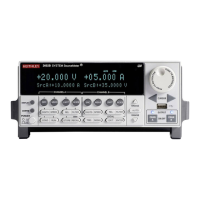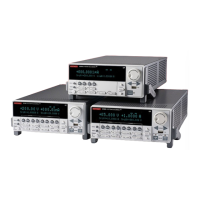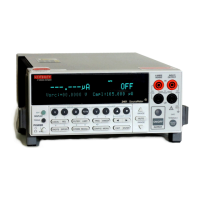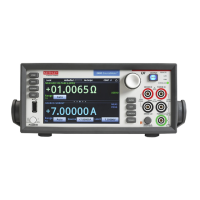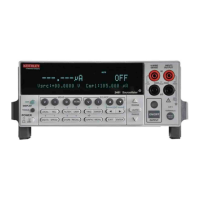Series 2600 System SourceMeters Reference Manual Display Operations 14-13
Return to Section 14 topics 2600S-901-01 Rev. A / May 2006
Load test menu
The LOAD TEST menu lists script tests (USER and FACTORY) that can be run
from the front panel. Factory script tests (functions) are pre-loaded and saved in
non-volatile memory at the factory. They are available in the FACTORY TESTS
submenu.
After a user script is loaded into the Series 2600, it is not automatically added to
the front panel USER TESTS submenu. A menu name and a chunk is added by
the user.
Saving a user script
After a user script is loaded into the Series 2600 it can be saved in non-volatile
memory. If it is not stored in non-volatile memory, the script will be lost when the
Series 2600 is turned off.
When loading a script from the Test Script Builder, the launch can be configured
to save the script in non-volatile memory (see “Using Test Script Builder” in
Section 2).
When loading a user script from another program, myscript.save() is used to
save the script in non-volatile memory (see “
Saving a user script” in Section 2).
Adding USER TESTS menu entries
The following function can be used in two ways to add an entry into the USER
TESTS submenu:
display.loadmenu.add(displayname, chunk)
display.loadmenu.add(displayname, chunk, memory)
displayname Name string to add to the menu.
chunk Chunk is the code to be executed.
memory Save or don’t save chunk and displayname in non-volatile
memory.
Set memory to one of the following values:
0 or display.DONT_SAVE
1 or display.SAVE
The default memory setting is display.SAVE.
The chunk can be made up of scripts, functions, variables and commands. With
memory set to display.SAVE, commands are saved with the chunk in non-volatile
memory. Scripts, functions and variables used in the chunk are not saved by
display.SAVE. Functions and variables need to be saved along with the script
(see “
Saving a user script”). If the script is not saved in non-volatile memory, it will
be lost when the Series 2600 is turned off. See Example 1 below.

